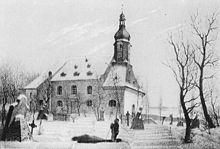Georg Koenitzer
Georg Könitzer (born November 24, 1818 in Hof , † December 31, 1885 in Hof ) was a German painter . His works also include drawings and photographs .
Life dates
Koenitzer was born the son of a master butcher and raised Protestant by his parents . Apart from his studies and a few study trips, he lived in the city of Hof. His house at Marienstraße 17 still exists. Könitzer attended the Academy of Fine Arts in Munich from 1844 to 1847 and worked as a painter, photographer and draftsman from 1850 until his death . From 1859 he was a drawing teacher at the grammar school and the Latin school in Hof. No children were born from his marriage to Antoinette Schobert.
Regional context
The city of Hof and its immediate surroundings were the central motifs of his work. His works are contemporary witnesses of urban development, including the onset of industrialization . They are also a source of the condition of historical buildings and their use in the 19th century. The great city fire of 1823 had a defining effect on him, the economic and social consequences of which were only considered to have been overcome after a decade. The increasing pressure of international competition made the local weaving mills difficult to create, which meant an increase in poverty and social tensions for the population. With the expansion of the railway, an economic improvement began for the region and the population of Hof tripled due to the immigration of workers.
plant
The surviving works that could be assigned to him include oil paintings , so-called collective pictures , drawings, individual lithographs and isolated photographs. The collective pictures mostly show Upper Franconian cities and landscapes with a central motif around which smaller pictures with additional views are grouped. In addition to cities such as Hof, Bamberg , Kulmbach , Bayreuth , Rothenburg ob der Tauber , Greiz and Plauen , the collector's pictures also depict sights such as the inclined plane , the Fichtelgebirge , the Großer Waldstein or the Luisenburg . The individual lithographs include images of the Hof town hall St. Lorenz , the Hof Monastery , the watch tower and Hofeck Castle . He was honored with the fact that Georg-Koenitzer-Strasse in Hof bears his name.
In the course of the fall of the Berlin Wall , Winfried Schmidt succeeded in providing an almost complete overview of Koenitzer's work with his second work. Due to the interest in cross-border history, the work The picturesque banks of the Elster, from the source to the exit , a title based on a similar work about the Saale , was rediscovered and reprinted. Drawings of the Vogtland beyond the Hof area are included, including the source of the White Elster or von Neuberg, today Podhradí u Aše , located in the Czech Republic (then in Austria-Hungary ) . Other individual images by the artist deal with the Hermitage several times, along with other motifs .
literature
- Winfried Schmidt: Georg Könitzer - A Hofer painter of the 19th century . Hof 1985. ISBN 3882670142 .
- Winfried Schmidt: Georg Könitzer - The picturesque banks of the Elster . Hof 1993. ISBN 3882670452 .
- Karl Sitzmann : artist and craftsman in Eastern Franconia . Kulmbach 1957. p. 305.
Web links
| personal data | |
|---|---|
| SURNAME | Koenitzer, Georg |
| BRIEF DESCRIPTION | German painter |
| DATE OF BIRTH | November 24, 1818 |
| PLACE OF BIRTH | Hof (Saale) |
| DATE OF DEATH | December 31, 1885 |
| Place of death | Hof (Saale) |

